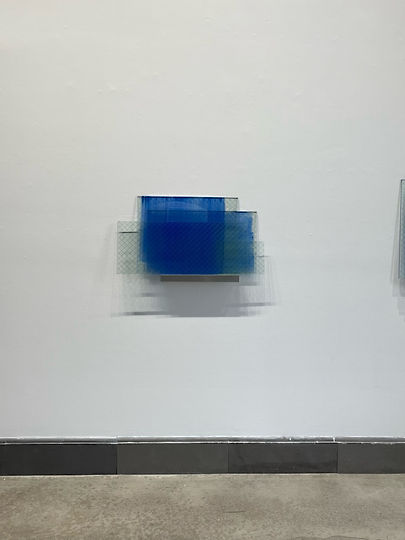
Arguing for Ephemerality
Russell Maltz
By William Corwin, November 29, 2023; images courtesy of the artist
All of Russell Maltz’ objects in his exhibition Breaking Blue (River House Arts, Toledo, October 20 through December 2) take as their basic premise the most clear acts of artistic intentionality—a careful, almost ikebana obsession with placement; a poetic forethought into levels of permeability and transparency. But juxtaposed against this is a complete rejection of the notion of permanence, and at times, as with the broken shards of glass on the floor, a Post-Modern ironic assessment of the idea of impermanence itself. The floor pieces in particular, 7 piles of glass propped a few inches off the poured concrete on wooden blocks, play the most with this dyad of art versus accident. They challenge us immediately by aspiring to be underfoot. They reflect the viewer looking down at them, but also expose the swirl of the concrete underneath. And they are already broken—engaging with Maltz’ palindromic love of finding art in detritus and making detritus into art.
The more stately wall assemblages distance themselves slightly from the sharp and dangerous in art. Three diaphanous works leaned against the wall on shelves, are meditations on the intensity of color. The artist isn’t interested in illusion though. Each sheet of glass leads the eye deeper into a more vibrant and dark shade of blue, but we are very cognizant of the sheets of glass by their unique dimensions, and the alternating edges and corners that overlap and intersect. It’s an Alber’s diagram in revolution or a Mondrian painting on its day off—Maltz again refuses to be chained in by the rules of etiquette that painters assign themselves. He goes even further by using ubiquitous safety glass—glass embedded with a grid of wires seen everywhere in architecture. Rather than wrap himself in the protective trappings of art materials, he pulls the everyday into pure conceptual art.
"Maltz allows the viewer to see the brushstroke from both sides—front and back, questioning the whole notion of image."
The painterly gesture can be detected in very consciously brush-applied pigment on the sheets of glass, and this is the sculptor’s pun on painting: Maltz allows the viewer to see the brushstroke from both sides—front and back, questioning the whole notion of image. Perhaps this is reminiscent of Namuth’s films of Pollock working—a frozen memory of action painting. The instantaneous freedom of these three dimensional works is explained not in wall text, but in a series of drawings—four hanging on the wall and an additional twelve under glass on a table in the center of the gallery. The works on paper are a combination of spontaneity and precision—the marks of translucent blue paint are placed one over the other like cascading streams of sapphire; pure motion and light. This energy is translated into the slender hanging glass pieces that hang on the walls and columns. Like the floor works, these narrow transparent shards both reflect the viewer and the light from the gallery windows, transmit Maltz’ gentle blues, and reveal the mottled rough concrete of the columns behind. From brush, to glass, to gritty architectural backdrop, the artist’s hand is consistent, whether the medium itself is regular or inconstant, whole or fractured.






